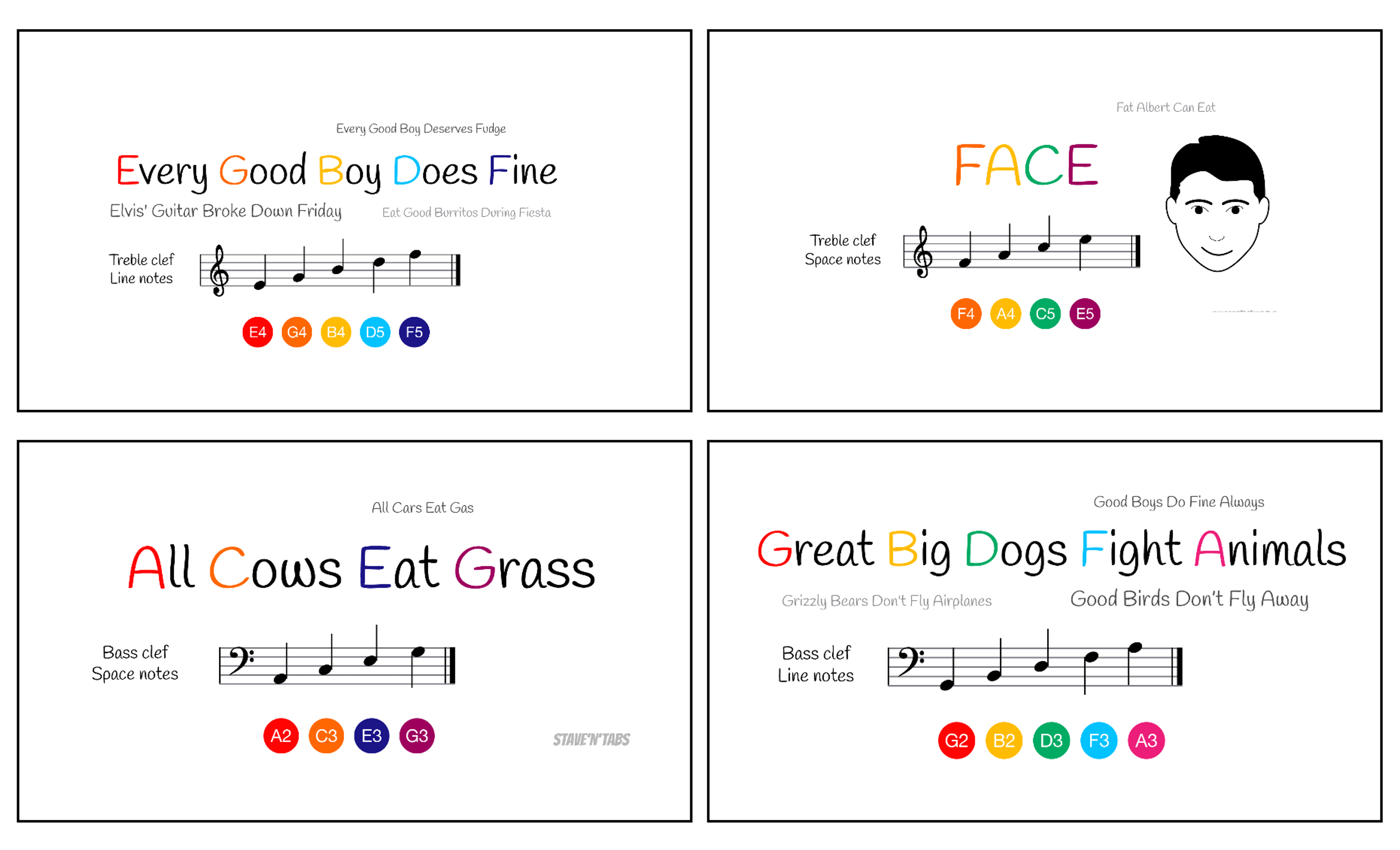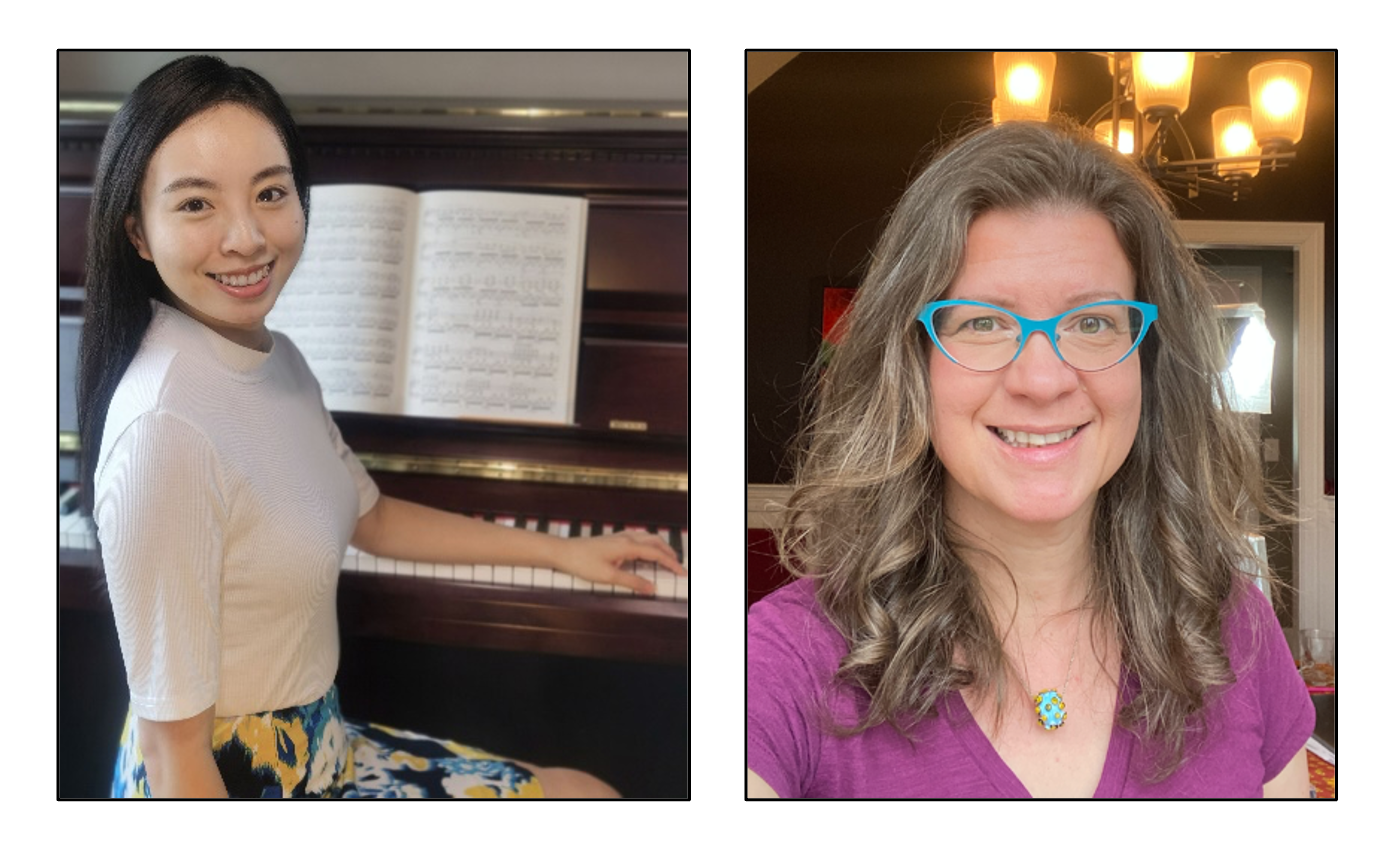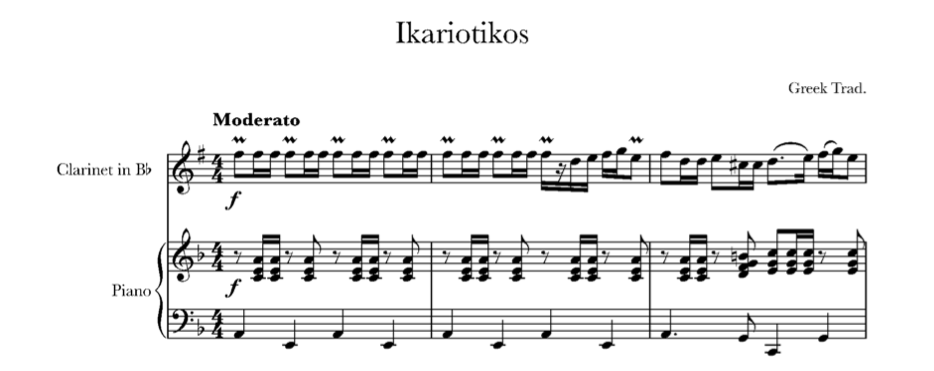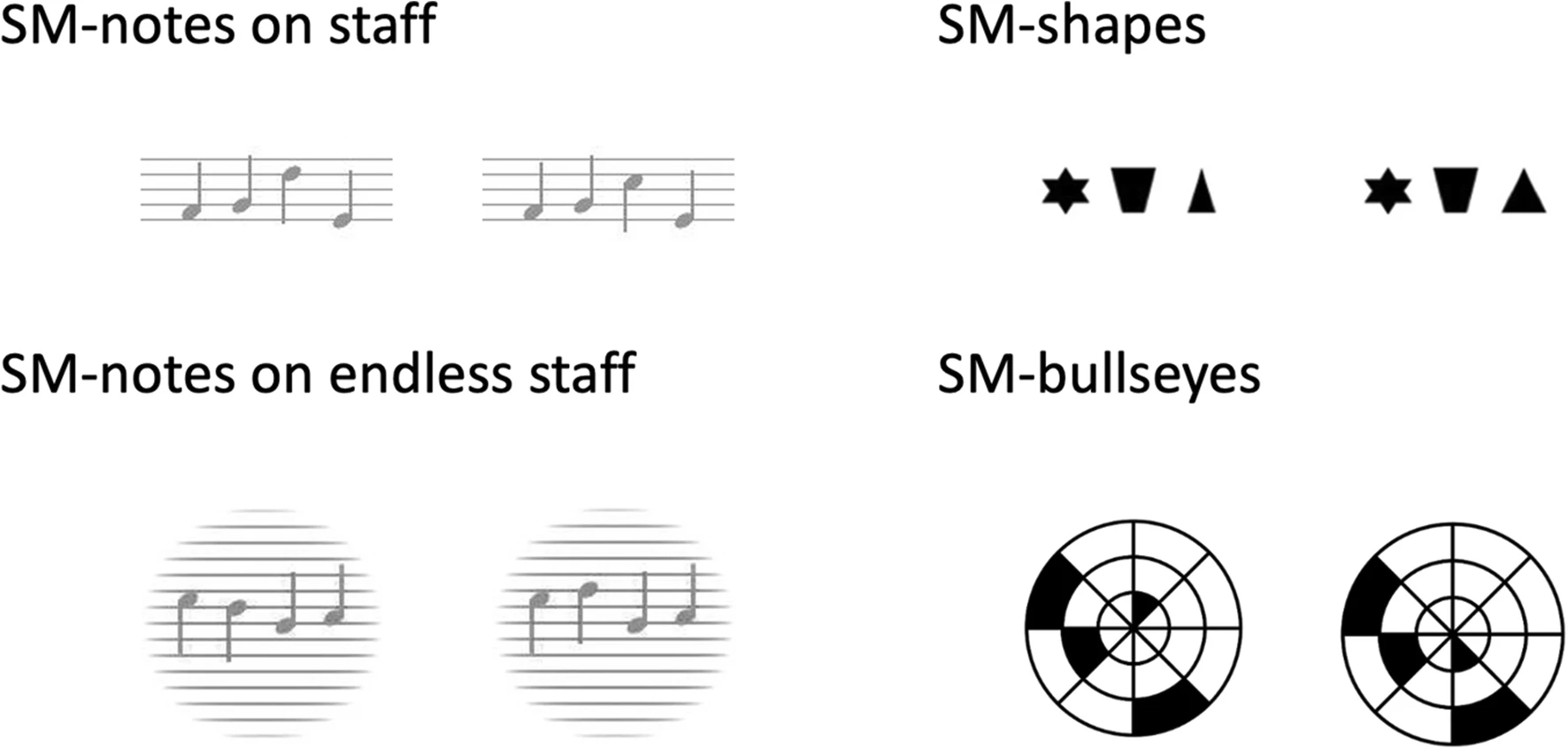In fourth grade, I learned to play the trumpet. Although my very musically inclined father attempted to teach me piano before then, my band director gets the credit for teaching me to read the music. Two key mnemonics were instrumental in my success in remembering the treble clef notes. Treble clef notes are the upper part of the staff and what trumpets play.
To read music, one must be able to discriminate between notes that land on a line or in space. As seen in the image below, the first mnemonic, “Every Good Boy Does Fine,” helps to remember the line notes of the staff if we use the first letter of each word. The second mnemonic, “FACE,” helps us remember the space notes of the staff as each note is a letter in the word, also seen in the top images below.

However, if you were a bass clef note reader (the lower end of the staff), you might have learned “Good Boys Do Fine Always” (for the line notes) and “All Cows Eat Grass” (for the space notes) as shown in the second line of images above.
Despite 9 years in a band and two more attempts to learn bass clef when my kids started learning to play piano, I quickly realized our home was much more musical when one of my kids or my husband was playing our piano or singing than when I attempted either!
Why is Musical Notation so Difficult?
One aspect of musical aptitude and expertise is the ability to read music along with matching pitch, understanding rhythms, and emoting musically. Ting-Yun Chang and Isabel Gauthier, the authors (pictured below) of the featured Attention, Perception, & Psychophysics article stated,
To understand the full spectrum of what it means to acquire musical expertise, [one line of research must] focus on the visual aspect of musical training: music reading.

Many people, including musicians, music appreciators, scientists, and mathematicians, have thought about the relationship between music and academic skills or emotion and music. Still, few have considered the perceptual processing of music notes and the skills needed to learn to read music. Chang and Gauthier believe that clarifying the origins of this skill was an important piece to understanding the puzzle of music and its influence on other cognitive skills.
In a brief interview about their study, Chang stated:
Many of the complex skills we learn in life have many facets, and these need to be studied individually so that we can eventually learn how they interact. For instance, there is evidence that practicing handwriting can help children learn to spell better. There is also evidence that musical training not only improves musical skills but can also influence general cognitive abilities. What is the role of music reading abilities in this process?
Their reasoning got me thinking about music from a perceptual perspective and my children’s experiences with learning to read music. Both my son and my daughter learned to play piano and clarinet expertly, playing each instrument as part of a formal ensemble for more than six years and each beginning the process of music at 4 years of age. Despite having the same piano teacher, band directors, and a built-in private instructor – their father, they learned to read music and play very differently. My son had no trouble sight reading, easily translating the notes into finger positions for both instruments and embouchures for his clarinet. In contrast, my daughter struggled to read notes, and ultimately learned to play both instruments by ear or through kinesthetic repetition where she memorized the hand positions and note relationships.
Take the image below of a sample of a musical score that includes three measures of notes for a clarinet to play (top line) and three measures of chords and notes for the piano to play (two bottom lines).

For the music novice, I imagine this music is relatively meaningless and probably looks like a bunch of black dots with some squiggles and lines. For the musical expert, this music looks fairly easy in rhythm and notes. While there are a few sharps and flats to keep in mind, it is fairly repetitious and straightforward. However, this music would be super challenging for my daughter. Because notes move around the line as she learns the music, she has to think about each note and what position she needs to place her fingers to play a note. Often, by the time she had figured out the note and hand position, the rest of the ensemble was three measures ahead.
Neither my husband nor I realized the extent to which our daughter struggled to learn notes until later in her musical career when she finally explained the challenges she faced with her music. We were flummoxed by her struggles because her performance on spatial reasoning and object recognition tests, like the ones used in the highlighted study, had been well above average.
Needless to say, the study conducted by Chang and Gauthier was fascinating to me as a semi-musician, a parent of musicians, and an experimental psychologist and professor. The researchers emphasized the importance of understanding the relationship between a music reading task and other visual tasks. They also recognized the importance of developing good and reliable measures to assess different abilities.
Musical notes, Shapes, and Ziggerins, Oh My
Working with almost 100 participants with varying degrees of musical experience, Chang and Gauthier identified that the first goal of their study was to improve the assessment of music reading. To develop better assessments, they designed different tasks so that participants had to match or remember stimuli.
Take the image below. In one set of tasks, Sequential Matching (SM), participants experienced different types of visual stimuli: (1) realistic music stimuli, like notes on a staff (upper left), (2) abstract music stimuli, like notes on an endless staff (bottom left), (3) general real object shapes, like stars or triangles (top right), and (4) general visual patterns based on a bullseye (bottom right). These visual recognition tasks allowed Chang and Gauthier to determine if music note reading was a domain-specific ability developed for music stimuli alone that was separate from a more general visual ability, such as used to process different visual patterns.

The researchers also measured two broad types of general abilities that could influence how well people performed in music reading tasks: general intelligence and general object recognition, or how well a person can recognize similar objects. General intelligence was measured with a version of the standardized Raven’s Progressive Matricesinventory. General object recognition was assessed using two different tests. Participants had to either recognize a novel artificial object or match them. Examples of the artificial objects referred to as Greebles, Ziggerins, and Sheinbugs are represented in the figure below.
The researchers wanted to determine how much these general abilities contributed to music note reading.

Tetris for Music Notes?
After controlling for performance on the visual object recognition and intelligence tasks, the different music tasks were still correlated with each other. These results suggested that reading musical notation is not just a visual task that can be predicted by general abilities, but it also can turn into its own specialized ability. Specifically, that specialized ability is associated with music reading and does not fully depend on how good a person is at other things, like matching or remembering objects.
In terms of the impact of musical training experience on the different tasks with notes, they found that the predictors of performance differed between novice and expert music readers. In the plot below, experts with increasing levels of music experience (top right plot below) were better at matching notes (y-axis and shown by the steeper line), than individuals categorized with no or very limited music experience, as shown by the flatter line (top left plot below).
Also in the plot below, we can see that novices who are better at object recognition (top right of the novice figure) performed better on note matching tasks than those novices who were not as good at object recognition (bottom left of the novice figure). The researchers suggested that perhaps at first, notes are simply like any nonsense shapes, and individuals who are generally good at object recognition are also the ones that perform better matching sequences of notes. But in those who read music frequently (as seen in the bottom right expert figure below), notes may have acquired new meaning and specialized representations in the brain, and their processing, at least in some tasks, no longer seems to depend on general object recognition (as indicated by the relatively flat line, small positive correlation between object recognition ability and note matching).

The Beauty of Music and its Notes
As humans, we are of course not born knowing what a music note entails on the various scales our cultures have created. However, we do innately respond to tones and combinations of sounds with various emotions. While the ability to create songs is shared by many species (from humpback whales to humans to birds to flies), no other species has shown an ability to write it down so that it can be shared with others who can then replicate that music from complex visual stimuli. Rather, most of the non-human species share their music through mimicry and variation on a theme.
Given this unique adaptation to share information in a written form and the variability in musical skills across humans, it seems very likely that perceiving visual musical stimuli depends on some general visual and cognitive skills initially that are then specialized through experience. The validation of the different assessments in this study provides a path for clarifying the relationship between general domain skills and specific domain skills needed to visually process music notes.
While it might be interesting to look at the evolution of visual processing in the context of musicality, one key result of this study emphasizes the importance of practice. As Chang concluded in an interview,
If you are wondering whether you’d be good at learning to read music, consider this: those who are good at object recognition learn to read music more easily. Moreover, this skill appears to be more unique with more practice reading music (that is, it becomes less related to other visual skills). Eventually, how good you get at reading music may depend more on how much time you devote to it than on your general abilities.
Regardless of the modality by which one learns to play music or the cognitive skills that may be facilitated by music, the ultimate pleasure is experiencing the music. As I listen to the birds outside my window, some of my favorite music is listening to my husband or son playing our piano or hearing my daughter sing. I have as much joy and peace when I hear them play or sing as the music I have linked. Enjoy!

Featured Psychonomic Society article
Chang, T. Y., & Gauthier, I. (2021). Domain-specific and domain-general contributions to reading musical notation. Attention, Perception & Psychophysics, 83, 2983–2994. https://doi.org/10.3758/s13414-021-02349-3
